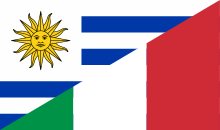 | |
| Total population | |
|---|---|
| 1304 (ISTAT: 2014) | |
| Regions with significant populations | |
| Languages | |
| Religion | |
| Catholic Church |
Uruguayans in Italy are people born in Uruguay who emigrated to Italy or Italian citizens of Uruguayan descent.
 | |
| Total population | |
|---|---|
| 1304 (ISTAT: 2014) | |
| Regions with significant populations | |
| Languages | |
| Religion | |
| Catholic Church |
Uruguayans in Italy are people born in Uruguay who emigrated to Italy or Italian citizens of Uruguayan descent.
No less than one-third of Uruguayans are of Italian descent; and thousands of Italian-Uruguayans hold Italian passports. These reasons help explain why so many Uruguayans immigrated to Italy in search of opportunities. An important group of Uruguayan footballers are playing or played in Italian teams. There are also some Italian-born people of Uruguayan descent.
Expatriate Uruguayans have their own associations in Italy, notably the Italy-Uruguay Cultural Association [1] [2] and two Consultative Councils. [3]

The Uruguay national football team represents Uruguay in international men's football, and is administered by the Uruguayan Football Association, the governing body for football in Uruguay. The national team is commonly referred to as La Celeste.

Argentina has a racially and ethnically diverse population. The territory of what today is Argentina was first inhabited by numerous indigenous peoples. The first white settlers came during the period of Spanish colonization, beginning in the 16th century. The Spaniards imported African slaves, who would go on to become the first Afro-Argentines. Following independence from Spain in the 19th century and well into the 20th century, numerous migration waves took place, with Argentina being the second most popular destination for migrants in the early 20th century, after the United States. Most of these migrants came from Europe.

Guillermo Daniel Rodríguez Pérez is a Uruguayan professional footballer who plays as a centre back for Sud América.

Greek Uruguayans are Uruguayan residents either fully or partially of Greek descent or Greece-born people who reside in Uruguay.
Bruno Montelongo Gesta is a Uruguayan professional footballer who plays as a right-back.

Juan Martín Mugica Ferreira was a Uruguayan football player and manager who played as a defender. He represented his country at the 1970 FIFA World Cup.

The German community in Uruguay numbers ca. 10,000 German expatriates and 300,000 people of German descent. Most of them live in the Montevideo area, although there are German minorities in Paysandú, Río Negro, San José and Canelones.

A Lithuanian Uruguayan is a Uruguayan citizen who is fully or partially of Lithuanian descent.
Uruguayans in Spain are people born in Uruguay who emigrated to Spain. As of 2022, there are over 80,000 Uruguayans living in Spain, mostly in Catalonia.

Emigration from Uruguay is a migratory phenomenon that has been taking place in Uruguay since the early 20th century.

Uruguayans in France are people born in Uruguay who emigrated to France.
Uruguayan Venezuelans are people born in Uruguay who live in Venezuela, or Venezuelan-born people of Uruguayan descent. Modern estimates put the figure of Uruguayans in Venezuela at ca. 9,000.
Uruguayan Chileans are people born in Uruguay who live in Chile, or Chilean-born people of Uruguayan descent.
Uruguayans in Sweden are people born in Uruguay who live in Sweden, or Swedish-born people of Uruguayan descent. As of 2013, there were over 4,000 Uruguayans living in Swedish territory.

Uruguayan Mexicans are people born in Uruguay who live in Mexico, or Mexico-born people of Uruguayan descent.

A Polish Uruguayan is a Uruguayan citizen of full or partial Polish ancestry.
Uruguayan Bolivians are people born in Uruguay who live in Bolivia, or Bolivian-born people of Uruguayan descent.
Uruguayan Ecuadorians are people born in Uruguay who live in Ecuador, or Ecuadorian-born people of Uruguayan descent.

Hungarian Uruguayans are people born in Hungary who live in Uruguay or Uruguayan-born people of Hungarian descent.

Uruguayans in Germany are people born in Uruguay who live in Germany, or German-born people of Uruguayan descent.